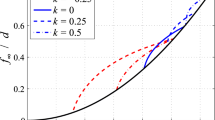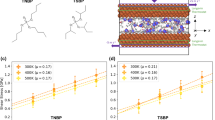Abstract
The unusually low friction of polytetrafluoroethylene, PFTE, is utilised in many commercial applications1. Unfortunately this low friction is often accompanied by rather high wear, and it is generally necessary to modify the polymer, usually by the incorporation of solid inorganic filler particles, to reduce the wear to acceptable levels1,2. Although several attempts have been made to establish the mechanism of this improved wear behaviour, the optimisation of filler type, size and concentration remains an empirical exercise, and several relatively simple wear testing machines have been developed to assess prospective materials3,4. These tests attempt to reproduce the sliding conditions encountered in practice. A widely used test is the pin-on-disk configuration where a fixed pin of polymer is loaded against a rotating disk. The load and relative velocity are fixed and the pin describes a circular path over the disk surface for a pre-determined period, after which the wear is measured, generally by weighing the polymer pin. Important additional variables are the environment, the surface topography of the disk, the temperature and the geometry of the pin5. In the process of conducting such a series of measurements we have identified and report here an additional variable which may be of general importance: the radius, R, of the path described by the pin on the disk.
This is a preview of subscription content, access via your institution
Access options
Subscribe to this journal
Receive 51 print issues and online access
$199.00 per year
only $3.90 per issue
Buy this article
- Purchase on Springer Link
- Instant access to full article PDF
Prices may be subject to local taxes which are calculated during checkout
Similar content being viewed by others
References
Tribol. Int. 6(6), 213–293 (1973).
Briscoe, B. J. & Tabor, D. in Polymer Surfaces (eds Clark, D. T. & Feast, W. J.) (Wiley, New York, 1978).
Lee, L. H. (ed.) Advances in Polymer Friction and Wear (Polymer Science and Technology Series 5A and 5B, Plenum, New York, 1974).
Brown, R. D. Test Methods in Boundary Lubrication, An Appraisal of World Literature (eds Ling, E. F., Klaus, E. F. & Fein, P. S.) (ASME, London, 1969).
Lancaster, J. K. in Polymer Science, A Materials Science Handbook (ed. Jenkins) Ch. 14 (North-Holland, Amsterdam, 1972).
Briscoe, B. J., Steward, M. D. & Grozcek, K. A. Wear 42, 99–102 (1977).
Pooley, C. M. & Tabor, D. Proc. R. Soc. A329, 251–274 (1972).
Briscoe, B. J. & Tabor, D. Self-Lubricating Polythenes (Colloques Internationaux du CNRS, No. 233, 1974).
Briscoe, B. J., Pogosian, A. K. & Tabor, D. Wear 27, 19–34 (1974).
Author information
Authors and Affiliations
Rights and permissions
About this article
Cite this article
Briscoe, B., Stolarski, T. Combined rotating and linear motion effects on the wear of polymers. Nature 281, 206–208 (1979). https://doi.org/10.1038/281206a0
Received:
Accepted:
Published:
Issue Date:
DOI: https://doi.org/10.1038/281206a0
This article is cited by
-
Wear Behavior of Polyaryletherketones Under Multi-directional Sliding and Fretting Conditions
Tribology Letters (2015)
Comments
By submitting a comment you agree to abide by our Terms and Community Guidelines. If you find something abusive or that does not comply with our terms or guidelines please flag it as inappropriate.



